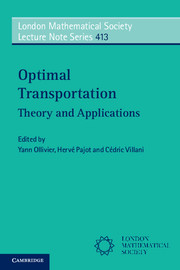Book contents
- Frontmatter
- Contents
- List of contributors
- Preface
- PART 1 SHORT COURSES
- PART 2 SURVEYS AND RESEARCH PAPERS
- 8 Computing a mass transport problem with a least-squares method
- 9 On the duality theory for the Monge–Kantorovich transport problem
- 10 Optimal coupling for mean field limits
- 11 Functional inequalities via Lyapunov conditions
- References
11 - Functional inequalities via Lyapunov conditions
from PART 2 - SURVEYS AND RESEARCH PAPERS
Published online by Cambridge University Press: 05 August 2014
- Frontmatter
- Contents
- List of contributors
- Preface
- PART 1 SHORT COURSES
- PART 2 SURVEYS AND RESEARCH PAPERS
- 8 Computing a mass transport problem with a least-squares method
- 9 On the duality theory for the Monge–Kantorovich transport problem
- 10 Optimal coupling for mean field limits
- 11 Functional inequalities via Lyapunov conditions
- References
Summary
Abstract
We review here some recent results by the authors, and various coauthors, on (weak, super) Poincaré inequalities, transportation-information inequalities or logarithmic Sobolev inequality via a quite simple and efficient technique: Lyapunov conditions.
Introduction and main concepts
Lyapunov conditions appeared a long time ago. They were particularly well fitted to deal with the problem of convergence to equilibrium for Markov processes; see [23, 38–40] and references therein. They also appeared earlier in the study of large and moderate deviations for empirical functionals of Markov processes (for examples, see Donsker and Varadhan [21, 22], Kontoyaniis and Meyn [33, 34], Wu [47, 48], Guillin [28, 29]), for solving the Poisson equation [24].
Their use to obtain functional inequalities is however quite recent, even if one may afterwards find hint of such an approach in Deuschel and Stroock [19] or Kusuocka and Stroock [35]. The present authors and coauthors have developed a methodology that has been successful for various inequalities: Lyapunov–Poincaré inequalities [4], Poincaré inequalities [3], transportation inequalities for Kullback information [17] or Fisher information [32], super Poincaré inequalities [16], weighted and weak Poincaré inequalities [13], or [18] for super weighted Poincaré inequalities. We finally refer to the forthcoming book [15] for a complete review. For more references on the various inequalities introduced here we refer to [1, 2, 36, 46]. The goal of this short review is to explain the methodology used in these papers and to present various general sets of conditions for this panel of functional inequalities. The proofs will of course be only schemed and we will refer to the original papers for complete statements.
- Type
- Chapter
- Information
- Optimal TransportTheory and Applications, pp. 274 - 287Publisher: Cambridge University PressPrint publication year: 2014
References
- 6
- Cited by

